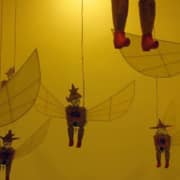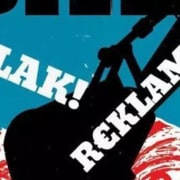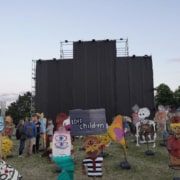
A portion of Uji Handoko Eko Saputro’s work ‘Speculative Entertainment No.1 Sydney Edition’.
Indonesia’s art world has come a long way since the fall of Soeharto’s New Order regime in 1998. After the demise of authoritarianism, Indonesian artists enjoyed unprecedented artistic freedom, as well as major commercial success in the regional and global art scenes.
Exhibitions like Indonesian Eyes: Fantasies and Realities at the Saatchi Gallery in London (2011), Trans-Figurations/Indonesian Mythologies at Espace Culturel Louis Vuitton in Paris (2011), and Indonesia’s participation as guest of honour at the Frankfurt Book Fair (2015) are just a few examples of the increasing interest in Indonesian culture and society outside Southeast Asia. But this international success and newfound artistic freedom has come with a new set of challenges.
(Still) talking politics
While not all Indonesian artists engage with social and political issues in their work, the generation of artists that emerged in the mid-1990s saw social injustice, regime oppression and social critique as important points of departure for their art.
Artists such as Dadang Christanto, Heri Dono, and Arahmaiani, as well as Nindityo Adipurnomo and Mella Jaarsma (who co-founded Indonesia’s first independent art space, Cemeti Gallery, now Cemeti Art House, in 1988) came into prominence and represented Indonesia in international events in the period before and after reformasi. Their work documented the ills of the New Order and was, in some cases, a form of resistance against the ruling regime. Because of the harsh censorship of the time, these artists often used humour and elements from mythology to cloak their criticism of the state.
The generation of artists that followed after the fall of the regime, including Eko Nugroho and groups like ruangrupa and the “Window Group” (Kelompok Seni Rupa (KSR) Jendela), found that a heavy emphasis on social and political themes, as well as international curators’ preference for work on these subjects, limited their artistic practice. Eager to embrace new developments in the global art scene, they sought to distinguish themselves from the previous generation by exploring intersections with personal identity and issues that were informed by their locality.
This is not to suggest that the generation of artists that emerged after 1998 abandoned the politically engaged work of their predecessors. Taring Padi, for example, continued to highlight social and political concerns, but emphasised that artists should work collectively with and for the people, rather than simply representing them or talking on their behalf. Made using low cost materials and techniques like silkscreen and woodcuts, works by Taring Padi were signed as a collective rather than by individual artists.
More recently, young artists and collectives, such as Ketjilbergerak, have collaborated with people from different backgrounds, such as educators, scientists and activists, in creative practices that embraced diverse communities in both urban and rural areas. Ketjilbergerak’s projects are varied but are always focused on addressing community concerns through the framework of art making – and with the aid of social media – beyond gallery walls.
While Indonesian artists have engaged with a more diverse subject matter, some issues remain sensitive, both in the art world and among the Indonesian public, such as the anti-communist mass killings of 1965-66. From 2014, however, there has been an increase in Indonesian art works and exhibitions, both at home and abroad, that have attempted to address the issue. Artists who are second- or third-generation survivors of the 1965-66 violence have inherited stories of trauma from their family members or communities, and some have begun to address the issue through artistic and cultural projects.
Events such as the OK Video festival’s Orde Baru (2015), Museum Bergerak 1965 (2016) and Gejolak Makam Keramat (2017), the latter a performance by female survivors of 1965-66, have sought to question and challenge the mainstream anti-communist narrative. Indeed, the use of cultural and artistic approaches seems to be the only option available for addressing this traumatic past and challenging the persistence of anti-communist rhetoric in Indonesia. The relative openness of the art world (and its limited circulation) may have allowed Indonesian artists to explore issues that have been previously hidden or seen as untouchable because they are sensitive.
Post-boom: implications and development
Indonesia’s success in the regional and global art scenes can be traced to the changes brought about through reformasi. Critical art works, avoided by private collectors during the New Order because of their political content, were suddenly in high demand, and mostly by Indonesian collectors.
In October 2008, Sotheby’s Hong Kong sold a painting by Nyoman Masriadi for US$296,800, a record price for Southeast Asian art at the time. It was a sale that caused major ripples in the Indonesian art world. Suddenly it was possible to become a full-time artist and be financially secure.
The strong pull of the market also had serious implications for the practices of younger artists. Many were unable to resist the temptation and began churning out works to feed demand. There was little room for experimentation, and most artists stuck to the winning formula of satirical or hyper-realist genres.
Further, as it was much harder to sell video, installation and performance art to private collectors, painting came to dominate. One art critic noted that this second art boom (the first was in the mid-1980s) diminished the intellectual engagement of many Indonesian artists. It also affected other key players in the art world such as curators, critics and academics. These roles, not strictly defined in Indonesia, became even more entangled as many joined the art boom. When the art market slowed down in about 2013, Indonesian artists found that they needed to be more careful in deciding whether they wanted to present themselves as an alternative to the mainstream commercial market or as part of it.
New institutions, new directions?
On a positive note, Indonesian arts infrastructure in the post-reformasi period has received a boost from both the private and public sectors. The late arrival of the new Indonesian Agency for the Creative Economy (Badan Ekonomi Kreatif Indonesia, Bekraf) is indicative of the government’s interest in developing the arts in Indonesia (even if it is aligned with economic goals). Since its inception in 2015, Bekraf has sponsored the Indonesian pavilion at the Venice Biennale and has provided support for local biennales. In the private sector, the opening of Museum Macan (The Museum of Modern and Contemporary Art in Nusantara) would appear to finally position Indonesia alongside other Southeast Asian countries with international art museums.
The development of Indonesian arts infrastructure has occurred in conjunction with the growth of the three major art events in Indonesia, the Jakarta Biennale, the Yogya Biennale and Art Jog, an annual art fair that since 2008 has showcased works by established and emerging Indonesian artists and aims to be truly open and accessible to everyone. The organisers of these events have shown a willingness to engage with ideas and artistic practices that not only push the boundaries but also keep in touch with the local and historical context.
A new generation of Indonesian artists and art collectives, such as Tintin Wulia, Uji (Hahan) Handoko, Elia Nurvista and Jatiwangi Art Factory (JAF) are now well known for their diverse and exciting projects. Their works explore issues such as global migration, institutional critique, and the politics of food. JAF has also organised an annual art festival and residency program outside the known urban art centres. Further, these artists have a strong focus on participatory art. The audience is central to the manifestation of the artwork.
Yet even 20 years after the fall of the New Order regime, artists remain wary. Recent years have seen an increase in censorship of works that challenge the dominant narrative in public spaces by certain civil society groups, such as the Islamic Defenders Front (FPI).
Nevertheless, the arts world remains a largely safe space for engaging with and interrogating sensitive social and political issues. Indonesian artists continue to use their creativity and skills to participate in society. While many artists continue to create individual works, increasing collaboration among artists and nongovernmental organisations, students, and diverse communities outside the relatively small art world could pave the way for more discussions about tolerance and inclusiveness in Indonesia.









